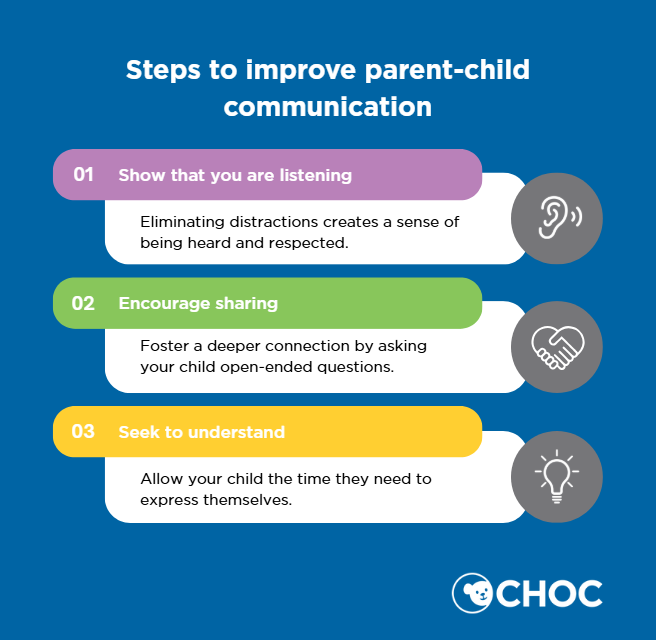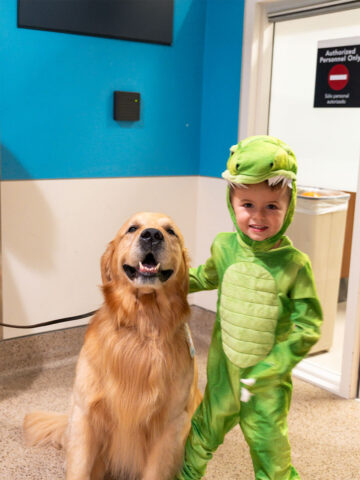By Dr. Guadalupe Gutierrez, pediatric psychologist at CHOC
Active listening tips to overcome communication challenges with your child
Is communication a challenge for you and your child? When communicating with your child becomes tough, it can be a frustrating experience for everyone. Remember that miscommunications can be a typical part of a caregiver-child relationship, but with effort and patience—and by using active listening tips—it’s possible to improve communication. These active listening tips can help caregivers connect more deeply and build stronger, more positive relationships with their children.
Communication is an integral part of everyday life, and research indicates that individuals spend approximately 50% of their waking hours listening to others. Active listening is an important part of effective communication. It involves paying attention and showing understanding, which can help form a better relationship between a caregiver and child.
On the other hand, poor communication can lead to conflict and misunderstandings, so it’s important to use effective communication skills, like active listening, to improve social interactions.
Showing empathy and understanding through active listening can promote a better relationship between the speaker and the listener. So, what are some active listening tips caregivers can use to improve their communication and relationships with their children?
Steps to improve parent-child communication
When communication between a caregiver and child has become challenging and tense, using active listening tips can help caregivers and children express their thoughts, feelings and needs more effectively. Below are some active listening tools you can use to foster healthy communication with your child:
1. Show that you are listening
- Eliminate distractions
- Use verbal and nonverbal language
- Maintain attentive presence
2. Encourage sharing
- Ask open-ended questions
- Summarize and paraphrase
- Use reflective statements
3. Seek to understand
- Avoid judgement
- Practice patience
- Seek clarification
Active listening tools
Show that you are listening
- Eliminate distractions: Engaging in other activities like watching TV or using your phone while your child is speaking can give your child the impression that their words aren’t valued. By setting aside distractions, you show that their thoughts and feelings are important to you. This creates a sense of being heard and respected.
- Utilize verbal and nonverbal cues: Your body language and brief verbal acknowledgments (e.g., “Hmm,” “I see”) can help your child see that you are present during conversations. Responding in a way that aligns with their mood—such as showing enthusiasm when they’re excited—also reinforces empathy and engagement.
- Maintain attentive presence: Maintaining eye contact and being mindful of your responses throughout the conversation signals that you’re engaged. Regularly asking about their thoughts and feelings can improve their comfort level, encouraging more open communication.
- Allow uninterrupted expression: Resist the urge to interrupt before your child has completed their thoughts. Even when you may disagree or feel compelled to correct misconceptions, it’s important to honor their right to express themselves fully. This approach promotes a nonjudgmental environment supportive of honest dialogue.
Encourage sharing
- Ask open-ended questions: Encourage your child to elaborate on their thoughts and feelings by asking questions that require more than a simple “yes” or “no” answer. For example, instead of asking, “Did you have a good day?” try using an open-ended question like, “What was the best part of your day?” This approach shows genuine interest and invites deeper conversation.
- Summarize and paraphrase: Reflecting on what your child has said shows that you’re actively listening and helps ensure mutual understanding. For instance, you might say, “So, you’re feeling frustrated because the project didn’t go as planned. Is that right?” This not only clarifies their message but also validates their emotions.
- Use reflective statements: Mirroring your child’s feelings shows empathy and reinforces that you value their perspective. If they express anger, you could respond with, “It seems like you’re really upset about what happened.” This approach fosters a supportive environment where your teens feel understood.
- Validate their emotions: Acknowledging your child’s feelings, even if you don’t agree with their viewpoint, helps them feel respected and heard. Phrases like, “I can see why you’d feel that way,” or “That sounds really tough,” can make a significant difference in how your teen perceives the conversation.
Seek to understand
- Avoid judgment: Listen to understand, not to respond. Even if you disagree, avoid forming opinions or making judgments until you’ve fully grasped your child’s perspective. This approach encourages open dialogue and trust.
- Practice patience: Allow your child the time they need to express themselves. Remember, they may process their thoughts more slowly than they speak. Resist the urge to interrupt or finish their sentences. Your patience shows that their words are valued.
- Seek clarification: If something is unclear, ask open-ended questions to gain a better understanding. For instance, “Can you tell me more about what happened?” or “How did that make you feel?” This shows genuine interest and helps prevent misunderstandings.

Benefits of embracing active listening tips
It is important that caregivers use effective communication tools, like active listening, with their children because these tools will help to strengthen the caregiver-child bond. Additionally, communication tools, like active listening, promote trust in a relationship.
By using active listening tips, caregivers can support healthy discussions that help children develop critical thinking and communication skills that will help them navigate difficult situations in the future.
When caregivers model active listening, they show their children what healthy communication looks like and provide a reference for future interactions. Remember to cherish and create meaningful conversations with your children, as this strengthens your bond and supports their emotional development.
Get more expert health advice delivered to your inbox monthly by subscribing to the KidsHealth newsletter here.
Get mental health resources from CHOC pediatric experts
The mental health team at CHOC curated the following resources on mental health topics common to kids and teens, such as depression, anxiety, suicide prevention and more.





